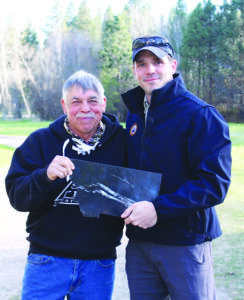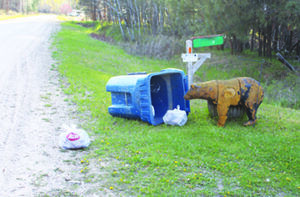
When Roger and Sharon DiBrito heard from their neighbors Tony and Linda Neumayer that they had spotted a black bear with a radio collar in their backyard, it didn’t take long for the DiBritos to arrange a Carlton Creek Wildlife Corridor Neighborhood meeting at their home. Guests of honor at the meeting were the Bitterroot Valley’s newest Fish, Wildlife and Parks Bear Conflict Technician for Region 2, Bruce Montgomery, and Jessica Reyes, Wildlife Program Biologist for Wind River Institute, and her Karelian Bear dog named Joni. Several neighbors showed up as well. The neighborhood is located in the wooded river bottom northeast of Florence and has a large amount of wildlife traffic of all kinds, including deer, turkeys, mountain lions, moose and an occasional bear. The turkeys can be a bother, but the lions and bears are a more serious concern.
Montgomery, who only started on the job in May, said that FWP was taking bear conflicts very seriously and that the Bitterroot Valley would be his primary focus, although he would respond to bear conflicts in other parts of the region. Montgomery said that there were a lot of black bears in the Bitterroot and conflicts are on the rise. He said he had reason to believe from conversations with the public that many of the conflicts go unreported. He said FWP was wanting to take a very proactive approach to prevention in the Bitterroot and the main part of his job would be helping people become more “bear aware” and reducing the attractants that proliferate in the Bitterroot. Attractants are many, but include accessible garbage, fruit trees, bird feeders, chicken coops, compost piles, dog food on the porch, etc.

Although bears are on rare occasions trapped and moved or on even rarer occasions killed by FWP, these actions are a last resort and depend upon very special circumstances. For the most part it doesn’t do any good to trap a bear and move it.
“There are a lot of black bears in the Bitterroot,” said Montgomery. “As long as the attractants remain in an area, even if you remove a bear, another bear will simply come and take its place.” He said it was FWP policy not to trap any bears so long as attractants remain unmitigated in the problem area.
“The best thing people can do is become more ‘bear aware’ and prevent the bears from finding their place that interesting to begin with. If there are no attractants, the bears will for the most part just walk on by,” he said.

FWP offers more than good advice in this regard, they also offer help. Montgomery said that the agency works with lots of nonprofit organizations and other agencies to help people reduce the attractants on their property. One partner is Defenders of Wildlife. They have a program that will reimburse 50% of the cost for up to $500 for an electric fence.
“The offer is good for the entire Bitterroot Valley,” said Montgomery. “There are a lot of unsecured chickens, fruit trees and bird feeders and a lot of that can be secured with an electric fence and a lot of it can only be secured with an electric fence.”
Another partner is Wildlife Services that addresses conflicts related to livestock. They too have an electric fencing program if the problem involves livestock.
“I’m willing to help with design and construction,” said Montgomery, “I can also help provide some materials.”
He said the agency really likes some buy-in on the part of the landowner. “We found in the past that without skin in the game by the landowner, they tend not to be maintained, and sometimes just not even used. So, we like to have a partnership where we both work to get it done and have it used correctly in the future,” said Montgomery. He said exceptions do occur if a bear goes so far as to enter a human structure or do significant property damage, depending on the circumstances, in which case they may trap a bear or even take lethal means to remove a bear.
Montgomery cautioned that there was a growing Grizzly bear population in the region and “one day in the future it is highly likely that there will be grizzlies living in the Bitterroot.” He said they are already passing through.
Jessica Reyes from the Wind River Institute and her dog Joni offered another solution for avoiding bear conflicts. The Karelian Bear Dog is used in the United States in many wildlife agencies for bear control. The Wind River Institute uses Karelian Bear Dogs to train bears to stay away from human-populated areas. They offer services across North America and Japan to reduce human-caused bear mortality and human-wildlife conflict without injury to the bear, the humans, or the dogs. (find out more about them at www.beardogs.org.)
A bear sighting can be reported through the Bitterroot College online at https://www.umt.edu/bitterroot-college/about/bears/default.php. Just click on the green button that says “Report Bear Sightings”.
Montgomery would prefer to have people call him directly, but he has not yet been issued a phone number by the agency. FWP Region 2 Headquarters phone is (406) 542-5500.
FWP Helena is (406) 444-2335.
Nadine Wisniewski says
Just wondering if Bitterroot Wildlife Corridor runs across I-93 including the Karelian Bear Dog Kennel and Bitterroot River
And
The 2017 Bitterroot Mountain Burn Area
Mike Miller says
No.
I-93 runs through 3 states in the New England area only.